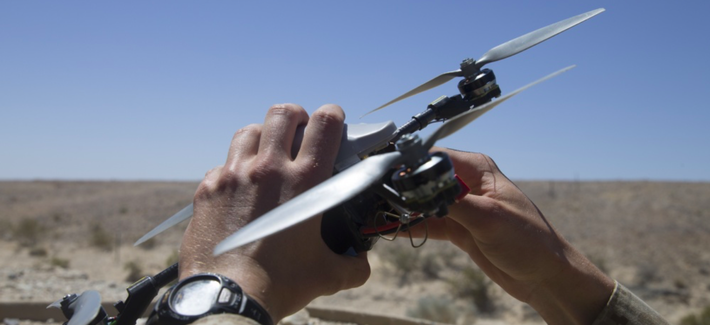 Engineers, researchers, and hackers will seek ways to protect warships and bases from hobby-type drones modified to kill.
Engineers, researchers, and hackers will seek ways to protect warships and bases from hobby-type drones modified to kill.
Lifting an idea from the Army and a name from the Star Wars universe, the U.S. Navy is assembling a team of engineers, researchers, and even hackers to develop ways to fight off swarms of cheap commercial drones.
The so-called JYN effort is the latest in a series of steps the Pentagon has taken to speed up development of new systems that can defend against drones that are readily available for purchase and easily modified for war..
“This is necessary to enable the [Navy] to gain a competitive advantage over the commercial advancement of unmanned systems technology and potential for nefarious use against [Navy] facilities and assets,” James “Hondo” Geurts, who leads Navy acquisition, wrote in a March 28 memo.
Navy officials are working with the Defense Digital Service to create a “team of highly technologically skilled and driven military and civilian…personnel” to work “in collaborative, startup-like spaces to rapidly develop new [counter-drone] products to address the evolving [drone] threats,” Geurts wrote.
The project expands the Defense Digital Service’s “successful efforts forming, training, and managing joint-service and Army teams,” he wrote.
The Defense Digital Service’s Army counter-drone project is called Jyn Erso after the character in the Star Wars film Rogue One.
Sailors, Marines, and Department of the Navy civilians can applyfor the positions on the counter-drone team. Specifically, they are looking for “software engineers, hardware engineers, hackers, security researchers, and other military and civilians with outstanding technical abilities,” Geurts wrote.
“This is an opportunity to grow the talent within the organization, leverage top technologists, learn new approaches, and bring them back to the [Navy],” he wrote.
The new announcement isn’t the first time that the Navy has sought ways to protect ships from swarms of small drones. In 2014, the Navy deployed a 30-kilowatt laser called the XN-1 LaWS aboard the amphibious transport dock Ponce in the Persian Gulf and released test footage of the laser shooting down a ScanEagle drone. Navy officials liked the idea of fending off enemy drone swarms with a laser that costs about a dollar per shot rather than $750,000 Standard missiles. The Navy bought two more of the lasers at $150 million each, with deployments scheduled for FY 2020.
Islamic State militants in Iraq and Syria have weaponized small commercial drones, rigging them with explosives. Last year, a drone was reportedly used in an assassanation attempt on Venezuelan President Nicolás Maduro.
Even unarmed drones can cause chaos, particularly if struck by aircraft traveling at high speeds. In recent months, authorities have shut down major airports in London, Dubai, and Newarkafter small drones were found in the area.
Patrick Tucker contributed to this report.

No comments:
Post a Comment